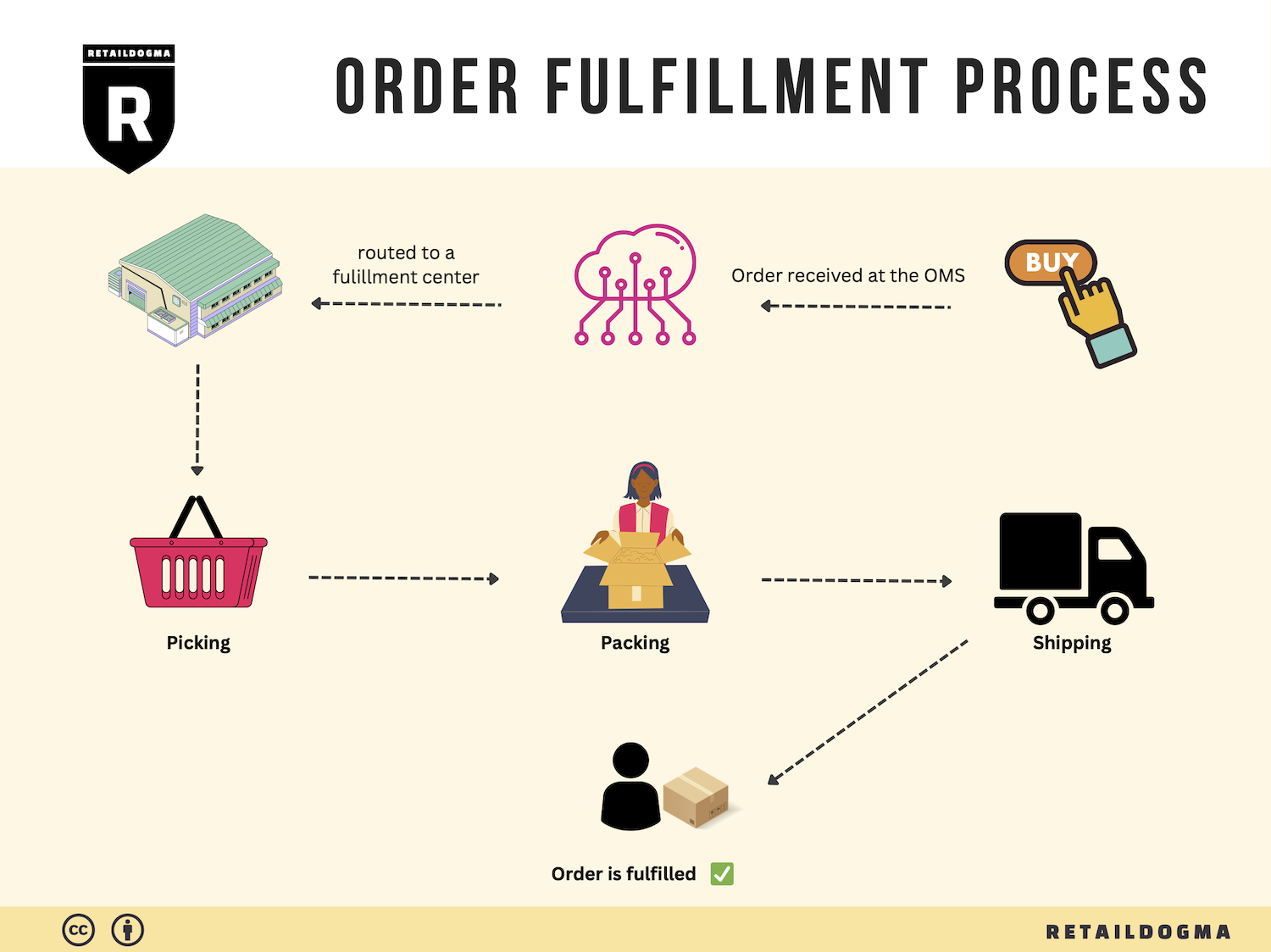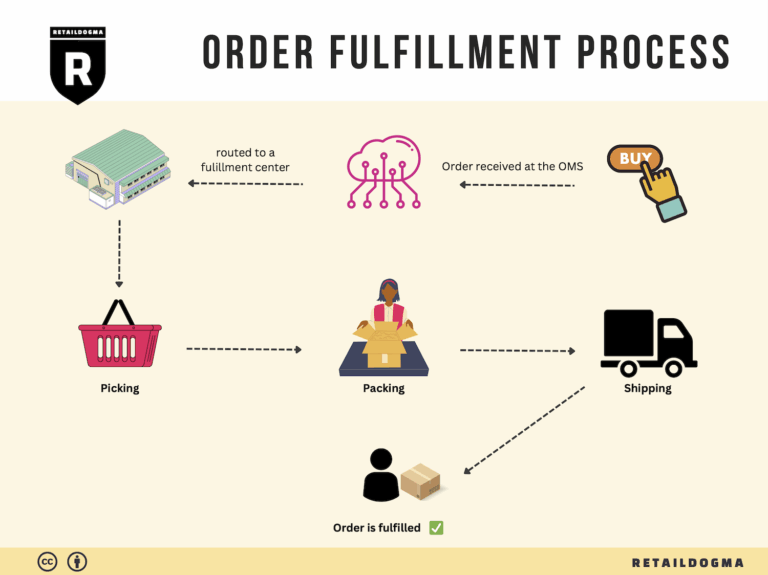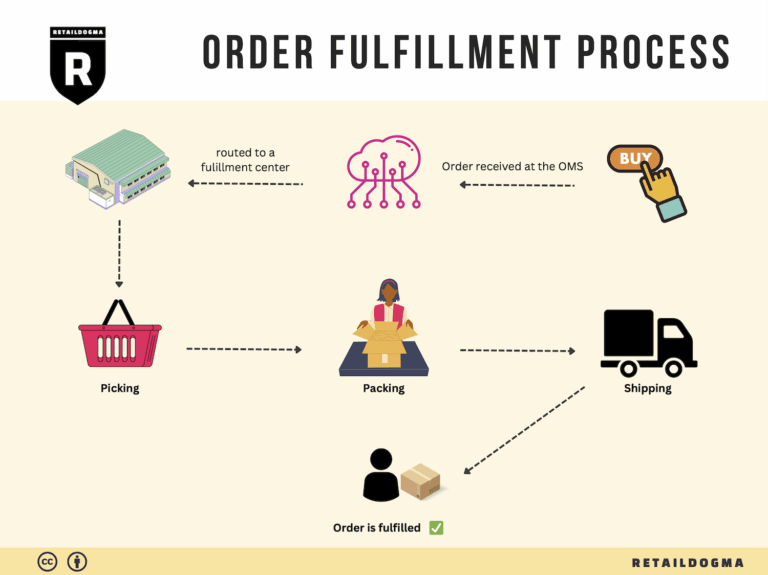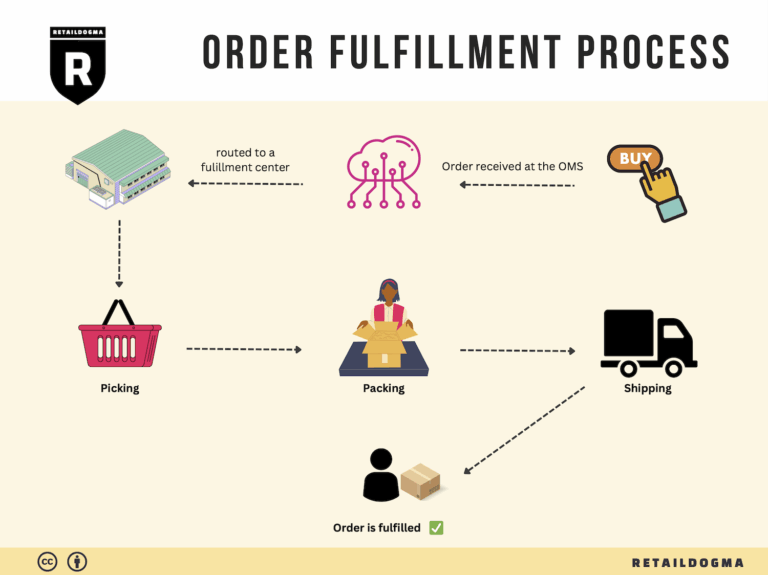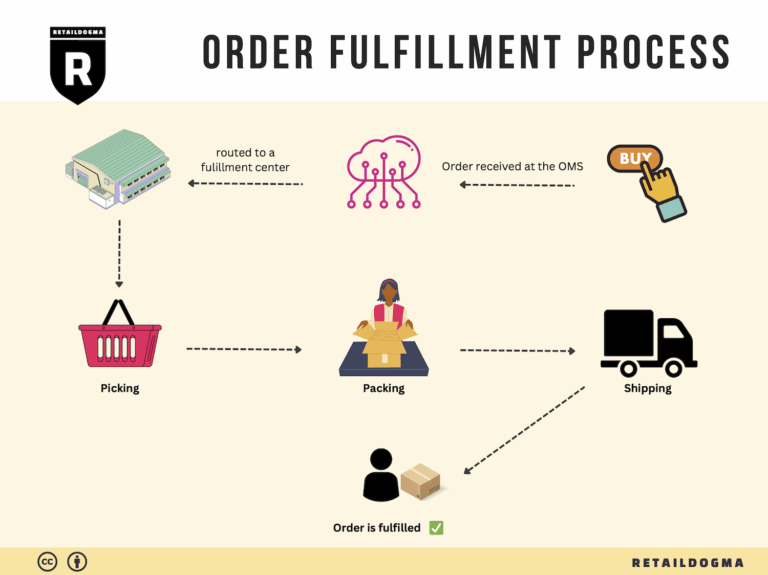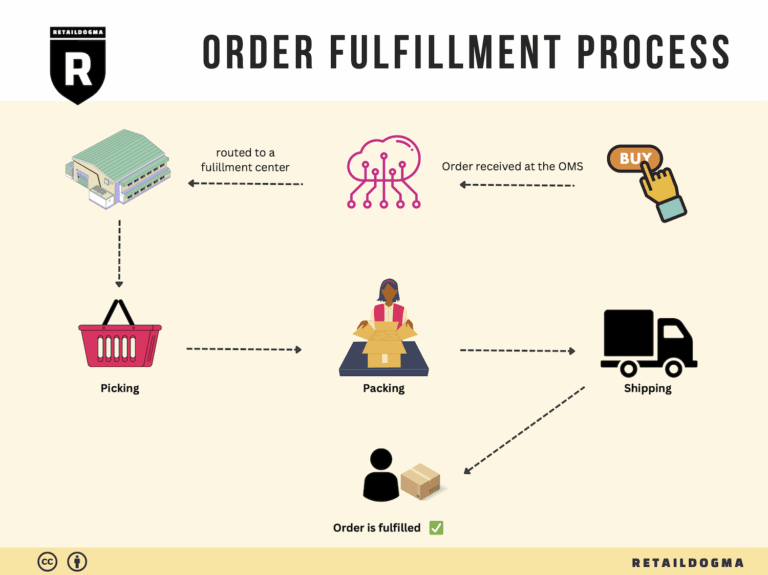How Order Fulfillment Works: A Step-by-Step Guide for Businesses
What is E-commerce Fulfillment? An Introduction for Growing Businesses
Understanding E-commerce Fulfillment
As an e-commerce business owner, you may find yourself grappling with a common challenge: the overwhelming task of packing and shipping orders. As your sales grow, so does the complexity of managing logistics. The process of fulfillment, which simply refers to getting a product to a customer, becomes a critical component of your operations. If you’re feeling buried under boxes, labels, and shipping timelines, you’re not alone. Many entrepreneurs face this hurdle, and it’s essential to address it to ensure your business can scale effectively.
In this guide, we will explore the various models of e-commerce fulfillment, including Third-Party Logistics (3PL) and Fulfillment by Amazon (FBA). Understanding these options will help you determine which model aligns best with your business needs. Each model has its unique advantages and can significantly impact your operational efficiency and customer satisfaction.
We will also delve into the core services that fulfillment partners typically offer. This includes warehousing, inventory management, order processing, packing, and shipping. Knowing what to expect from a fulfillment service can help you make informed decisions when selecting a partner.
Choosing the right fulfillment partner is crucial for your business’s success. In this guide, we will provide insights on how to evaluate potential partners, considering factors such as their technology, location, scalability, and customer service. These criteria will ensure that you select a partner who can grow with you as your business expands.
Lastly, we will discuss pricing structures in fulfillment services. Understanding how costs are calculated—whether through storage fees, pick-and-pack fees, or shipping rates—will empower you to budget effectively and avoid unexpected expenses.
The goal of this guide is to equip you with the knowledge and tools needed to make smart decisions about your logistics. By streamlining your fulfillment process, you can focus on what truly matters: growing your business and delighting your customers. Let’s embark on this journey to demystify e-commerce fulfillment and set your business up for success.
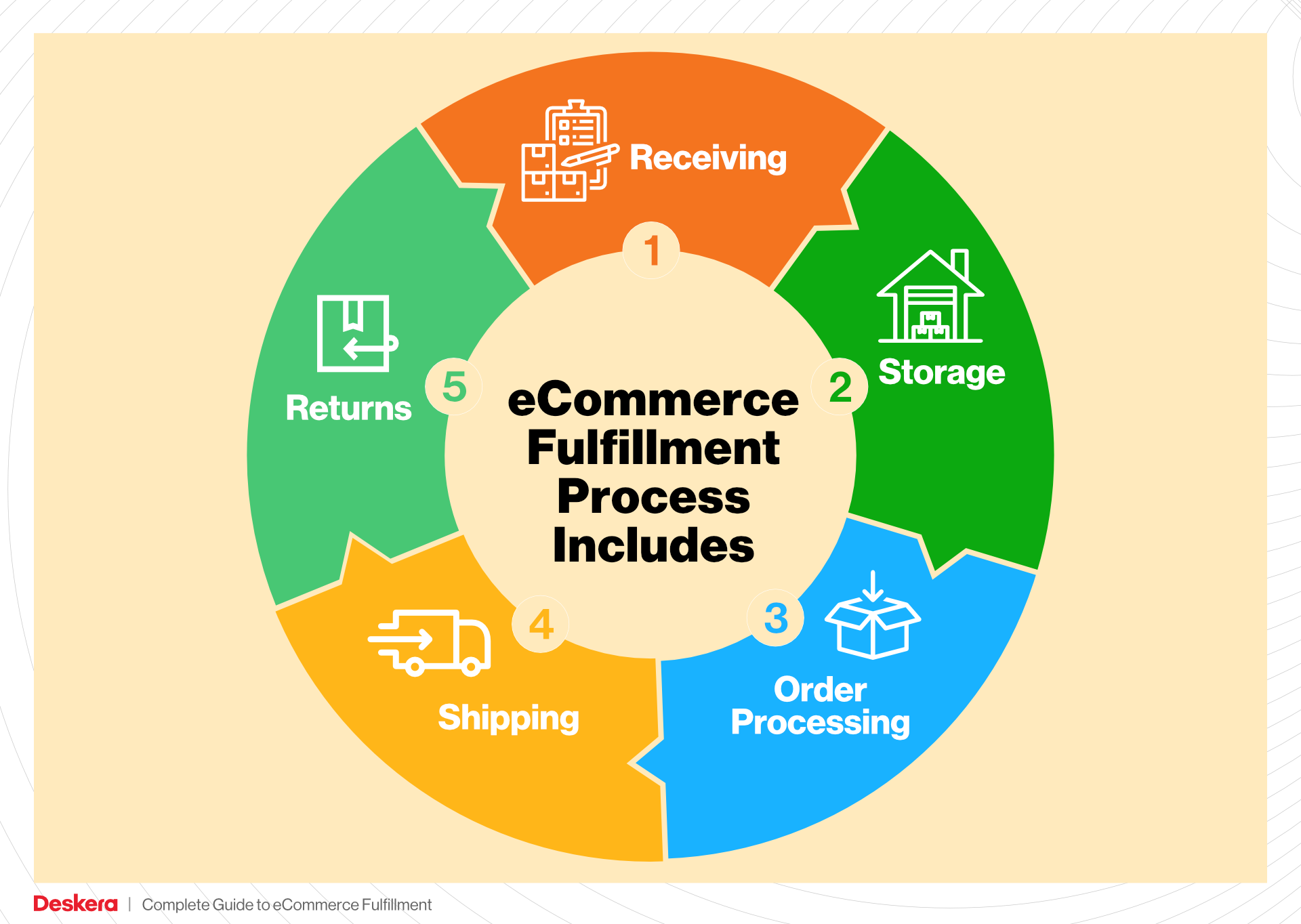
What You’ll Learn In This Guide
- What is E-commerce Fulfillment? An Introduction for Growing Businesses
- The Order Fulfillment Process: From ‘Buy’ Button to Customer’s Door
- Comparing Fulfillment Models: In-House vs. 3PL vs. Dropshipping
- A Deep Dive into Amazon FBA: Pros, Cons, and Who It’s For
- Core Services Offered by Fulfillment Centers
- How to Choose a Fulfillment Partner: A 6-Point Checklist
- Understanding Fulfillment Pricing: A Breakdown of Common Fees
- Frequently Asked Questions (FAQs) about Fulfillment
- Conclusion: Is Outsourcing Fulfillment the Right Move for Your Business?
- Important Disclaimer
The Order Fulfillment Process: From ‘Buy’ Button to Customer’s Door
1. Receiving Inventory
The first step in the order fulfillment process is receiving inventory. This involves the delivery of products from suppliers to your fulfillment center or warehouse. Upon arrival, items are checked against purchase orders to ensure accuracy in quantity and specifications. This process typically involves scanning the products using a barcode scanner, which helps in associating each item with a unique Stock Keeping Unit (SKU).
Importance: Accurate receiving is crucial because it sets the foundation for the entire supply chain. Any discrepancies at this stage can lead to stockouts or overstock situations, affecting sales and customer satisfaction.
Key Term: SKU (Stock Keeping Unit) – A unique identifier for each product that helps in tracking inventory levels and managing stock efficiently.
2. Warehouse Storage
Once the inventory has been received and verified, the next step is warehouse storage. This involves organizing and storing products in a systematic manner. Items are placed in designated locations, which could be shelves, bins, or pallets, depending on their size and type. Effective warehouse management systems (WMS) often utilize technology to optimize storage locations based on product demand and turnover rates.
Importance: Proper storage ensures that items are easy to locate and access, which directly impacts the efficiency of the picking process. A well-organized warehouse minimizes the time spent searching for products, leading to faster order fulfillment.
Key Term: WMS (Warehouse Management System) – A software application that helps manage and optimize warehouse operations, including storage, inventory tracking, and order processing.
3. Order Picking
After a customer places an order, the next step is order picking. This process involves retrieving the correct items from their storage locations based on the order details. Order pickers may use various methods, such as single order picking (picking one order at a time) or batch picking (picking multiple orders simultaneously). A pick list, which details the items and their locations, guides the pickers through the warehouse.
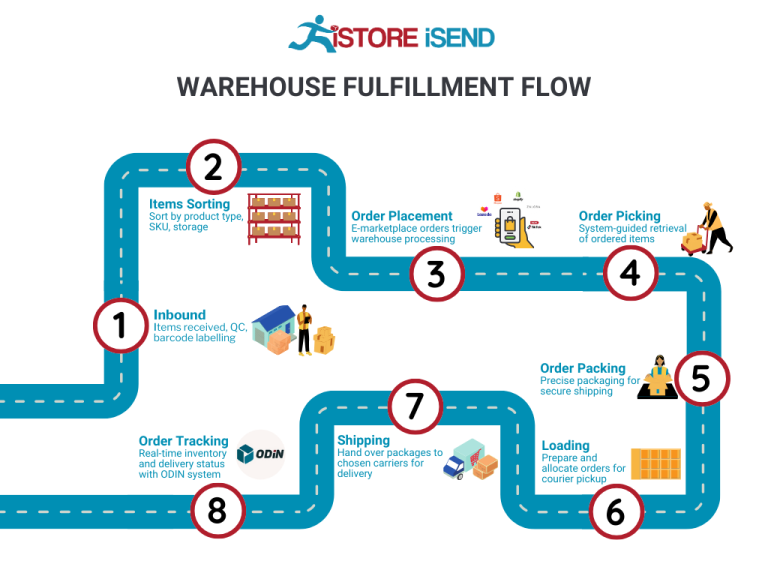
Importance: Efficient picking is critical for timely order fulfillment. Errors in picking can lead to incorrect shipments, resulting in returns and customer dissatisfaction. Therefore, accuracy during this phase is paramount.
Key Term: Pick List – A document or digital tool that lists the items to be picked for each order, along with their locations in the warehouse.
4. Order Packing
Once the items have been picked, they move to the packing stage. During this process, products are carefully packed into boxes or envelopes for shipping. This step involves selecting the appropriate packaging materials to ensure that items are secure during transit. Additionally, packing slips, which detail the contents of the shipment, are included in the package.
Importance: Proper packing is essential to prevent damage during shipping and to enhance the unboxing experience for customers. Well-packed orders can reduce return rates and increase customer satisfaction.
Key Term: Packing Slip – A document included in the shipment that provides information about the items contained within the package, serving as a receipt for the customer.
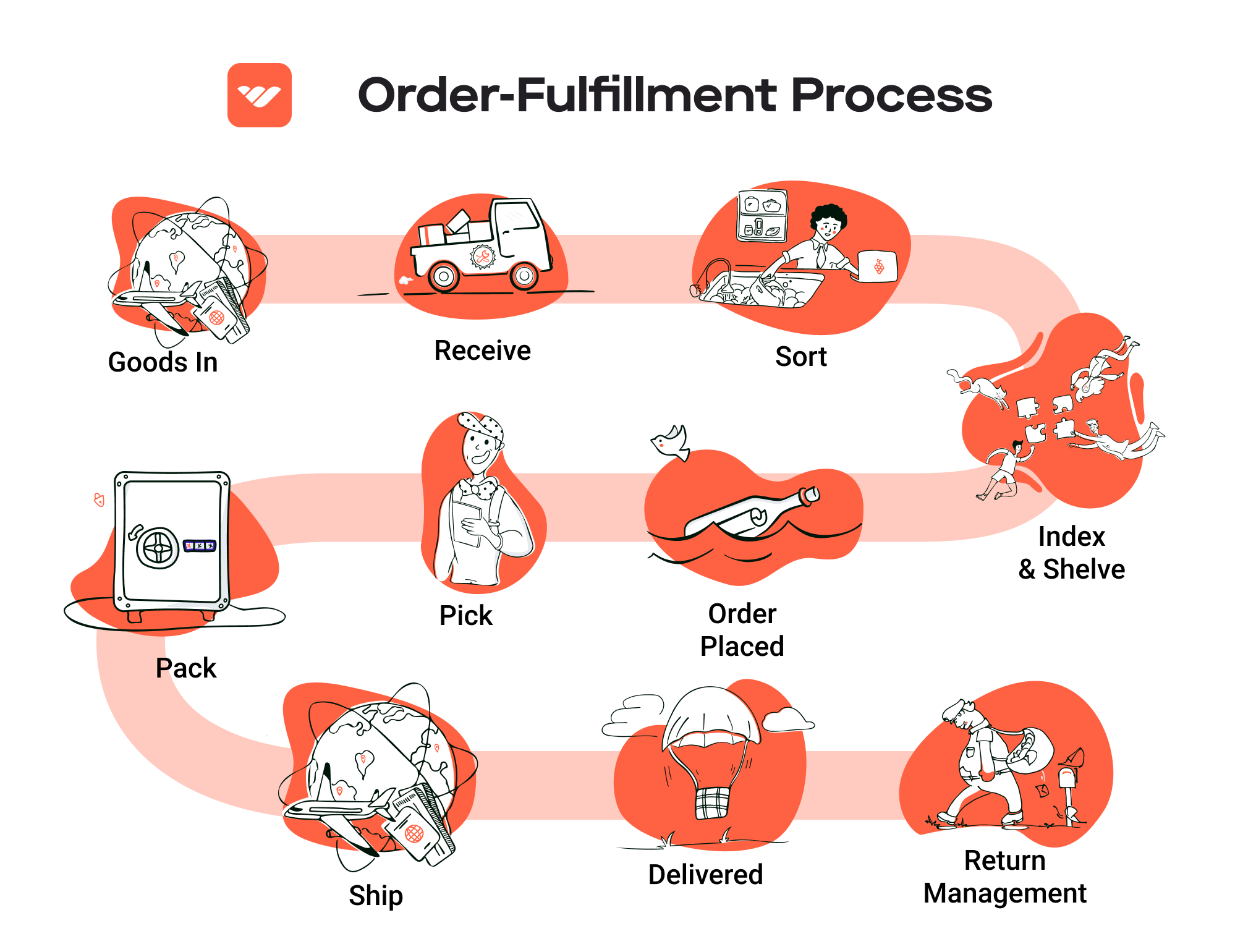
5. Shipping & Delivery
The final step in the order fulfillment process is shipping and delivery. Once the orders are packed, they are labeled and handed over to carriers for delivery. Businesses often have multiple shipping options, including standard, expedited, and same-day delivery, depending on customer preferences and budget. Tracking information is typically provided to customers, allowing them to monitor the status of their shipments.
Importance: Timely and reliable shipping is crucial for customer satisfaction. Delays in delivery can lead to negative reviews and lost customers. Thus, having a well-coordinated shipping process is vital for maintaining a competitive edge in e-commerce.
Key Term: Carrier – A company that transports goods, such as FedEx, UPS, or DHL, responsible for the physical delivery of packages to customers.
By understanding and optimizing each of these steps in the order fulfillment process, e-commerce businesses can enhance their operational efficiency, reduce costs, and ultimately improve customer satisfaction.
Comparing Fulfillment Models: In-House vs. 3PL vs. Dropshipping
Fulfillment Model Comparison
| Model | Who Handles Inventory | Best For (Business Stage) | Key Advantage | Key Disadvantage |
|---|---|---|---|---|
| In-House Fulfillment | The business itself | Established businesses | Greater control and customization | High overhead costs and complexity |
| Third-Party Logistics (3PL) | External logistics provider | Growing businesses | Scalable and cost-efficient | Less control over operations |
| Dropshipping | Supplier or manufacturer | Startups and small businesses | Low startup costs and risk | Lower profit margins and dependency on suppliers |
In-House Fulfillment
In-house fulfillment involves managing the entire logistics process within the business itself. This model requires the business to handle inventory management, order processing, packaging, and shipping directly. It is best suited for established businesses that have the resources and operational capacity to maintain their own fulfillment centers. The key advantage of in-house fulfillment is the level of control it offers. Businesses can customize their packaging, streamline operations, and ensure quality control over the entire process. However, this model comes with significant disadvantages, primarily the high overhead costs associated with warehousing, staffing, and technology investments. Additionally, managing logistics in-house can lead to complexities that may distract from the core business functions, especially during periods of rapid growth or seasonal demand fluctuations.
Third-Party Logistics (3PL)
Third-party logistics (3PL) providers offer outsourced logistics services that can encompass everything from warehousing and inventory management to transportation and order fulfillment. This model is particularly beneficial for growing businesses that need scalable solutions without the burden of managing logistics internally. A significant advantage of using a 3PL is the cost efficiency it can provide, as businesses only pay for the services they need, allowing for better cash flow management. Moreover, 3PLs often have established networks and technologies that can enhance shipping speed and reliability. However, the primary disadvantage is the reduced control over logistics operations. Businesses may face challenges with communication, service levels, and responsiveness, which can affect customer satisfaction. Additionally, relying on a third party may complicate the return process and inventory accuracy, potentially leading to stock discrepancies.
Dropshipping
Dropshipping is a fulfillment method where the retailer does not keep products in stock. Instead, when a product is sold, the retailer purchases the item from a third-party supplier who then ships it directly to the customer. This model is ideal for startups and small businesses looking to minimize upfront investment and risk. The key advantage of dropshipping is the low barrier to entry; businesses can start selling products without the need for inventory, warehousing, or fulfillment infrastructure. This flexibility allows entrepreneurs to test various products and markets with minimal financial commitment. However, dropshipping also comes with notable disadvantages. The profit margins are typically lower due to supplier markups, and businesses are highly dependent on their suppliers for product quality and shipping reliability. Any delays or issues from the supplier’s end can directly impact the retailer’s reputation and customer satisfaction. Furthermore, managing returns can be complicated, as the retailer has limited control over the fulfillment process.
Conclusion
When choosing a fulfillment model, businesses must assess their specific needs, resources, and growth strategies. In-house fulfillment offers control and customization but at a higher cost. On the other hand, 3PL providers can scale operations efficiently, albeit with some loss of control. Dropshipping presents an attractive option for new entrepreneurs due to its low risk, but it requires careful management to ensure quality and customer satisfaction. Understanding the nuances of each model will empower business owners to make informed decisions that align with their operational capabilities and market objectives.
A Deep Dive into Amazon FBA: Pros, Cons, and Who It’s For
Understanding Fulfillment by Amazon (FBA)
Fulfillment by Amazon (FBA) is a service offered by Amazon that allows sellers to store their products in Amazon’s fulfillment centers. Amazon takes care of storage, packaging, shipping, and customer service, enabling sellers to focus on other aspects of their business. When a customer orders a product, Amazon handles the entire fulfillment process, including shipping the product directly to the customer.
How FBA Works
-
Product Preparation: Sellers prepare their products according to Amazon’s guidelines. This includes packaging and labeling items appropriately to ensure they are ready for shipment to Amazon’s warehouses.
-
Shipping to Amazon: Sellers send their inventory to Amazon’s designated fulfillment centers. Amazon provides shipping labels and guidance on how to send products efficiently.
-
Storage: Once received, Amazon stores the products in their fulfillment centers. Sellers can monitor their inventory levels through the Amazon Seller Central dashboard.
-
Order Fulfillment: When a customer places an order, Amazon picks, packs, and ships the product on behalf of the seller. They also handle customer inquiries and returns.
-
Payment: After the sale, Amazon collects the payment from the customer and disburses the funds to the seller after deducting FBA fees.
Pros of Fulfillment by Amazon
1. Prime Eligibility
One of the most significant advantages of using FBA is that products become eligible for Amazon Prime. Prime members often prefer items that qualify for fast shipping, which can significantly boost sales.
2. Customer Trust
Amazon is a well-established brand known for its customer service. When sellers use FBA, their products benefit from Amazon’s reputation, which can lead to increased trust from customers. This trust can translate into higher conversion rates and customer loyalty.
3. Multi-Channel Fulfillment
FBA allows sellers to use Amazon’s logistics network to fulfill orders from other sales channels, such as their own websites or other e-commerce platforms. This feature streamlines operations and enables sellers to manage their inventory efficiently across multiple platforms.
4. Scalability
FBA is particularly advantageous for scaling businesses. As demand increases, sellers can easily send more inventory to Amazon without the need to invest in their own warehousing or logistics infrastructure.
5. Time Savings
By outsourcing fulfillment to Amazon, sellers can save considerable time and resources. This allows them to focus on marketing, product development, and other critical aspects of their business.
Cons of Fulfillment by Amazon
1. High Fees
While FBA offers numerous benefits, it also comes with significant costs. Sellers must pay storage fees for their inventory and fulfillment fees for each unit sold. These fees can quickly add up, particularly for low-margin products.
2. Strict Inventory Rules
Amazon has stringent rules regarding inventory management. Sellers must adhere to guidelines about restocking, labeling, and packaging. Failure to comply can lead to additional fees or even account suspension.
3. Commingling Risks
FBA utilizes a commingling inventory model, meaning that products from multiple sellers may be stored together. This can lead to potential issues if a seller’s products are mistakenly sent to customers when they ordered a different seller’s item. This risk can affect brand integrity and customer satisfaction.
4. Limited Control
Sellers relinquish a degree of control over their fulfillment process. This includes how their products are presented and packaged, which can impact brand perception. Additionally, sellers must rely on Amazon’s customer service, which may not always align with their own brand values.
5. Inventory Management Challenges
Managing inventory levels can be tricky with FBA. Sellers need to accurately forecast demand to avoid stockouts or overstocking, which can lead to excess storage fees.
Who is FBA Best For?
Fulfillment by Amazon is an excellent fit for various types of sellers, including:
- Small to Medium-Sized Businesses: Those looking to grow without investing heavily in logistics and warehousing can benefit significantly from FBA.
- E-commerce Entrepreneurs: New sellers entering the market can leverage Amazon’s infrastructure to start selling quickly without the complexities of order fulfillment.
- Brands with Seasonal Products: Sellers with fluctuating inventory needs can take advantage of FBA’s scalability to manage seasonal spikes in demand.
- Multi-Channel Sellers: Businesses selling across various platforms can streamline their operations by using FBA for order fulfillment from multiple sales channels.
In conclusion, while Fulfillment by Amazon offers numerous advantages, such as increased sales potential and time savings, it also comes with challenges that sellers must navigate. Understanding these pros and cons is crucial for any e-commerce business considering FBA as a fulfillment solution. By assessing their specific needs and weighing the benefits against the drawbacks, sellers can determine if FBA aligns with their business goals and operational strategies.
Core Services Offered by Fulfillment Centers
Inventory Management & Warehousing
Fulfillment centers provide comprehensive inventory management and warehousing services, which are crucial for e-commerce businesses. This service involves the systematic storage, tracking, and management of products within a designated warehouse space. Fulfillment centers utilize sophisticated inventory management systems that allow businesses to monitor stock levels in real-time, ensuring that they maintain optimal inventory levels and can quickly respond to fluctuations in demand.
Benefits:
1. Real-Time Visibility: Businesses gain access to real-time data on inventory levels, which helps prevent stockouts and overstock situations. This is vital for maintaining customer satisfaction and optimizing cash flow.
2. Cost Efficiency: By outsourcing inventory management to fulfillment centers, e-commerce businesses can reduce the overhead costs associated with maintaining their own warehouses. This includes savings on utilities, labor, and property maintenance.
3. Scalability: As a business grows, its inventory needs can change significantly. Fulfillment centers offer scalable solutions that allow companies to easily adjust their storage space and inventory management practices to meet demand without significant upfront investment.
Pick and Pack Services
Pick and pack services involve the selection (picking) of items from the warehouse and preparing them for shipment (packing). Fulfillment centers employ efficient processes and technology to ensure that orders are picked accurately and packed securely for delivery.
Benefits:
1. Speed and Efficiency: Fulfillment centers are optimized for speed, allowing for rapid order processing. This is particularly important for e-commerce businesses that promise quick delivery times to customers. Faster fulfillment means happier customers and potentially higher repeat business.
2. Accuracy: Automated systems reduce the likelihood of human error during the picking process. This accuracy not only enhances customer satisfaction but also minimizes return rates associated with incorrect orders.
3. Custom Packaging: Many fulfillment centers offer custom packaging solutions that can enhance brand identity and improve the unboxing experience for customers. This can include branded boxes, special inserts, or eco-friendly packaging options.
Kitting and Assembly
Kitting and assembly services refer to the process of combining multiple products into a single package or kit. This is often used for promotional bundles, gift sets, or special product configurations that require assembly before shipping.
Benefits:
1. Enhanced Product Offerings: Kitting allows e-commerce businesses to create unique product offerings that can differentiate them in the marketplace. Bundled products often encourage customers to purchase more, increasing the average order value.
2. Time Savings: By outsourcing kitting and assembly to fulfillment centers, businesses can save time and labor costs. This allows internal teams to focus on core business activities such as marketing and customer service, rather than labor-intensive assembly tasks.
3. Inventory Control: Kitting can simplify inventory management by reducing the number of SKUs a business needs to track. Instead of managing individual components, companies can track kits as singular items, making inventory management more straightforward.
Returns Management (Reverse Logistics)
Returns management, or reverse logistics, is the process of handling returned products. Fulfillment centers often provide specialized services to manage returns efficiently, including inspection, restocking, and processing refunds or exchanges.
Benefits:
1. Customer Retention: An efficient returns process enhances the customer experience, which is essential for retaining customers in the competitive e-commerce landscape. A hassle-free return policy can increase customer loyalty and encourage repeat purchases.
2. Data Insights: Fulfillment centers can analyze return data to provide valuable insights into customer behavior and product performance. Understanding why items are returned can help businesses improve their product offerings and reduce future return rates.
3. Cost Management: By managing returns effectively, fulfillment centers can help businesses minimize the costs associated with returns processing. This includes reducing the time spent on returns and optimizing the restocking process to recover inventory quickly.
In conclusion, fulfillment centers offer a suite of core services that can significantly enhance the operational efficiency of e-commerce businesses. By leveraging these services, companies can focus on growth and customer satisfaction while leaving logistics management to experts in the field. This partnership enables businesses to scale effectively, respond to market changes, and maintain a competitive edge in the e-commerce landscape.
How to Choose a Fulfillment Partner: A 6-Point Checklist
Location & Warehouse Network
Importance:
The location of your fulfillment partner’s warehouses is crucial for efficient logistics and timely delivery. A strategically placed warehouse network can significantly reduce shipping times and costs, especially if you are selling to a broad geographical area.
Questions to Ask:
1. Where are your warehouses located, and how do those locations align with our customer demographics?
2. What is your average shipping time for orders within our target regions?
3. Do you have a plan for expanding your warehouse network in the future?
Technology & Integrations
Importance:
In today’s digital age, robust technology and seamless integrations with your existing systems (like e-commerce platforms, inventory management software, etc.) are essential. This ensures real-time tracking, order management, and data analytics, which are vital for operational efficiency.
Questions to Ask:
1. What technology platforms do you use for order processing and inventory management?
2. Can your system integrate with our e-commerce platform and other tools we currently use?
3. Do you provide real-time tracking for shipments, and how can we access that data?
Specializations (e.g., Cold Storage, Oversized Items)
Importance:
Depending on your product line, you may need a fulfillment partner with specific capabilities, such as cold storage for perishable goods or handling oversized items. Choosing a partner with the right specializations can prevent damage, ensure compliance with regulations, and enhance customer satisfaction.
Questions to Ask:
1. What types of products do you specialize in handling?
2. Do you have facilities for specialized storage needs (e.g., temperature-controlled, hazardous materials)?
3. How do you ensure compliance with safety and regulatory standards for specialized products?
Scalability & Capacity
Importance:
As your business grows, your fulfillment needs will evolve. It’s vital to partner with a 3PL provider that can scale with you, ensuring they can handle increased order volumes without compromising service quality.
Questions to Ask:
1. How do you handle seasonal spikes in demand?
2. What is your current capacity, and how quickly can you scale up operations if needed?
3. Can you provide examples of how you’ve supported other clients during periods of rapid growth?
Pricing and Contracts
Importance:
Understanding the pricing structure and contract terms is critical for budgeting and financial forecasting. Transparency in pricing helps avoid unexpected costs and ensures that you’re getting value for your investment.
Questions to Ask:
1. Can you provide a detailed breakdown of your pricing model (e.g., storage fees, pick and pack fees, shipping costs)?
2. Are there any hidden fees we should be aware of (e.g., for returns, order modifications)?
3. What are the terms of the contract, and are there any penalties for early termination?
Customer Support & Reviews
Importance:
Excellent customer support is essential for resolving issues quickly and maintaining smooth operations. Additionally, researching reviews and testimonials can provide insights into the partner’s reliability and service quality.
Questions to Ask:
1. What customer support channels do you offer (e.g., phone, email, chat), and what are your support hours?
2. How quickly can we expect responses to our inquiries?
3. Can you share customer references or reviews that speak to your service quality and reliability?
Conclusion
Choosing the right fulfillment partner is a pivotal decision for your e-commerce business. By carefully evaluating potential partners against this checklist, you can ensure that you select a provider that aligns with your operational needs and growth aspirations. A solid partnership will not only enhance your logistics efficiency but also contribute to a better customer experience, ultimately driving your business’s success.
Understanding Fulfillment Pricing: A Breakdown of Common Fees
Initial Setup Fees
Initial setup fees are one-time charges that cover the costs associated with onboarding a new seller into the fulfillment network. These fees can vary significantly based on the complexity of your inventory and the specific fulfillment provider you choose. For example, Amazon’s Fulfillment by Amazon (FBA) program typically charges an initial setup fee that may include account setup, integration with your existing systems, and any necessary documentation or compliance checks.
To calculate initial setup fees, consider the following factors:
– Account Type: Different tiers of service may have different fees.
– Inventory Size: A larger inventory may require more setup time, thus increasing costs.
– Technology Integration: If your systems require custom integration with the fulfillment provider’s platform, this can add to the initial fees.
Receiving Fees
Receiving fees are charged when your products arrive at the fulfillment center. These fees cover the labor and processes involved in unloading, inspecting, and storing your inventory. The cost is typically calculated based on the number of units received and can vary depending on the type of items being processed (e.g., bulky or fragile items may incur higher fees).
Factors influencing receiving fees include:
– Unit Count: A higher number of units often leads to reduced per-unit costs due to economies of scale.
– Product Type: Specialized handling requirements for certain products can increase receiving fees.
– Time of Year: During peak seasons, such as holidays, receiving fees may increase due to higher demand for labor.
Storage Fees (per pallet/bin)
Storage fees are charged for the space your inventory occupies within the fulfillment center. These fees are typically calculated on a monthly basis and can vary based on the size of the storage unit (per pallet or per bin) and the duration of storage. Providers may have tiered pricing structures, with lower rates for larger quantities or longer commitments.
To estimate storage fees, consider:
– Volume of Inventory: The more space your inventory occupies, the higher the fees.
– Storage Duration: Longer storage times may incur additional fees, especially if items are deemed to be slow-moving.
– Seasonality: Some fulfillment centers may adjust storage fees based on seasonal demand fluctuations.
Pick & Pack Fees (per item/order)
Pick and pack fees are charged for the process of selecting items from storage and preparing them for shipment. This fee is typically calculated per order or per item, depending on the fulfillment provider’s pricing model. The complexity of the order can also affect the fee; for example, orders with multiple items may incur higher fees than single-item orders.
Key considerations for pick and pack fees include:
– Order Complexity: More items or special packing requirements can increase costs.
– Frequency of Orders: Regular orders may receive discounted rates.
– Special Packaging: If your products require special packaging or handling, additional fees may apply.
Shipping Fees
Shipping fees encompass the costs associated with transporting your products from the fulfillment center to the customer. These fees vary based on several factors, including the destination, weight and dimensions of the package, and the shipping method chosen (standard, expedited, etc.).
When calculating shipping fees, consider:
– Shipping Method: Different shipping options (e.g., ground vs. air) will have different costs.
– Distance: Longer distances generally incur higher shipping fees.
– Package Size and Weight: Heavier and bulkier packages will typically cost more to ship.
Tips for Getting an Accurate Quote
To ensure you receive an accurate quote for fulfillment services, consider the following tips:
- Provide Detailed Information: Share comprehensive details about your inventory, including dimensions, weights, and handling requirements.
- Ask for Itemized Quotes: Request itemized breakdowns of all potential fees to understand the total cost structure.
- Inquire About Discounts: Some fulfillment providers offer discounts based on volume or frequency of orders—be sure to ask.
- Review Terms and Conditions: Understand the terms associated with fees, such as minimum storage durations or peak season surcharges.
- Compare Multiple Providers: Don’t settle for the first quote; compare offerings from multiple fulfillment centers to find the best fit for your needs.
By understanding these common fulfillment pricing models and following these tips, e-commerce business owners can make informed decisions that align with their operational strategies and budgetary constraints.
Frequently Asked Questions (FAQs) about Fulfillment
1. What is Amazon Fulfillment SCK8?
Amazon Fulfillment SCK8 is one of Amazon’s fulfillment centers, strategically located to optimize shipping times and costs for sellers using Amazon’s platform. It serves as a warehouse for storing products and managing the order fulfillment process, including picking, packing, and shipping items directly to customers.
2. How does the fulfillment process work at Amazon SCK8?
At Amazon SCK8, the fulfillment process begins when an order is placed on Amazon. The center receives the order, locates the items in the warehouse, picks them, packs them securely, and then ships them to the customer. The entire process is designed to be efficient, leveraging advanced technology and automation to minimize handling time and errors.
3. What are the benefits of using Amazon’s fulfillment services?
Using Amazon’s fulfillment services, including SCK8, provides several benefits:
– Speed: Orders are processed quickly, often with same-day or next-day shipping.
– Scalability: Sellers can easily scale their operations without needing to manage their own warehouses.
– Reach: Access to Amazon’s vast customer base and Prime members.
– Technology: Leverage Amazon’s technology for inventory management and order processing.
4. How much do fulfillment services cost?
Costs for fulfillment services vary based on factors such as storage space used, the number of orders processed, and the type of products being shipped. Generally, sellers can expect to pay:
– Storage fees: Based on the amount of space their products occupy in the warehouse.
– Fulfillment fees: Charged per unit for picking, packing, and shipping items.
It’s advisable to review Amazon’s pricing page or consult with a fulfillment expert to get an accurate estimate based on specific business needs.
5. What is the difference between a warehouse and a fulfillment center?
A warehouse primarily serves as a storage facility for inventory, whereas a fulfillment center focuses on the entire order fulfillment process. Fulfillment centers handle picking, packing, and shipping orders, often incorporating technology and logistics strategies to streamline operations. In contrast, warehouses may not engage in order processing.
6. What is a 3PL (Third-Party Logistics)?
A 3PL (Third-Party Logistics) provider offers outsourced logistics services, which can include transportation, warehousing, and fulfillment. Businesses often partner with 3PLs to manage their supply chain more efficiently, allowing them to focus on core activities like marketing and sales while leaving logistics to specialized providers.
7. How can I track my inventory at Amazon Fulfillment SCK8?
Sellers can track their inventory at Amazon Fulfillment SCK8 through the Amazon Seller Central dashboard. This platform provides real-time updates on inventory levels, sales data, and order status, allowing sellers to manage their stock efficiently and make informed decisions about reordering.
8. Can I use Amazon SCK8 for international shipping?
Yes, Amazon Fulfillment SCK8 can be utilized for international shipping through Amazon Global. Sellers can list their products for international customers, and Amazon will handle the logistics, including customs clearance and international delivery. However, sellers should be aware of additional fees and regulations that may apply.
9. What should I consider when choosing a fulfillment center?
When choosing a fulfillment center, consider the following factors:
– Location: Proximity to your customer base can reduce shipping times and costs.
– Technology: Look for centers that use advanced technology for inventory management and order processing.
– Services offered: Ensure the center can handle your specific needs, such as kitting, bundling, or custom packaging.
– Scalability: Choose a center that can grow with your business and accommodate increased order volumes.
10. How can I improve my fulfillment efficiency?
To improve fulfillment efficiency, consider implementing the following strategies:
– Optimize inventory management: Use data analytics to forecast demand and manage stock levels effectively.
– Streamline processes: Evaluate and refine your picking, packing, and shipping procedures to minimize delays.
– Leverage technology: Utilize fulfillment software and automation tools to enhance order processing speed and accuracy.
– Regularly review performance: Analyze fulfillment metrics to identify areas for improvement and adjust operations accordingly.
Conclusion: Is Outsourcing Fulfillment the Right Move for Your Business?
Evaluating the Benefits of Outsourcing Fulfillment
Outsourcing your fulfillment process can provide significant advantages that enhance the efficiency and scalability of your e-commerce business. One of the primary benefits is time savings; by partnering with a fulfillment service, you can redirect your focus from logistics to core business activities such as marketing, product development, and customer engagement. This shift not only boosts productivity but also helps maintain a competitive edge in a fast-paced marketplace.
Scalability is another crucial advantage of outsourcing fulfillment. As your business grows, so do your logistical needs. A reliable fulfillment partner can easily adapt to your changing order volumes, ensuring that you can meet customer demand without the headaches of managing additional warehousing or staffing. This flexibility is essential for businesses looking to expand into new markets or launch new products without the burden of infrastructure investment.
Moreover, expertise in logistics and shipping is a significant asset that fulfillment partners bring to the table. They have specialized knowledge of shipping regulations, cost-effective carrier options, and inventory management strategies that can optimize your operations. This expertise can lead to reduced shipping times and costs, ultimately enhancing customer satisfaction.
However, it is crucial to choose the right fulfillment partner. Your decision should align with your business goals, customer expectations, and operational capabilities. Conducting thorough research and due diligence will help ensure that your selected partner can support your growth trajectory effectively.
As a strategic next step, consider auditing your current shipping process. Assess the time, resources, and costs involved, and evaluate whether a fulfillment partner could streamline your operations. Taking this proactive approach can illuminate pathways for growth and operational efficiency, positioning your business for success in an increasingly competitive landscape.
Important Disclaimer
⚠️ Important Disclaimer
The information in this guide is for educational purposes. Fulfillment services, pricing, and platform features change frequently. Always conduct your own due diligence and consult with providers directly before making business decisions.
